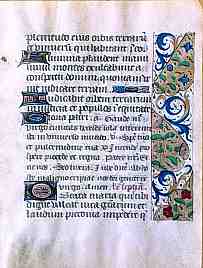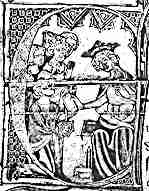 |
|
Initials
and Borders (3) |
|
The
most extravagantly decorated books were the grand and significant volumes
of display, emphasising the significance of social prestige and also the
role played by some of these works in the impressive public display of
religion. In the early medieval period, the highly treasured gospel
books like the Lindisfarne Gospels of the Book of Kells were lavishly
decorated. It is a reasonable assumption that these prestigious works have survived selectively over simpler and more humble working volumes. |
|
A
marvellous coiled dragon forms the letter P on a page of the late 7th century Lindisfarne Gospels (British Library,
Cotton Nero D IV, f.5), by permission of the British Library. |
|
The
massive Bibles which
sat on lecterns in the church, or the antiphoners
and graduals used
by the choir were often decorated. The missal
or breviary used by the priest was not necessarily lavishly treated, being a work
which was used behind the enclosure of the rood screen.
|
|
The
psalter was a
work of performance, and around the 13th century some of these were acquired
by wealthy members of the laity as prestige goods. These were made in
a smaller format, as they were not for the use of multiple members of
a choir, but had many of the prestige trappings of decoration with elaborate
initials and borders and lashings of gold
leaf. |
|
|
Leaf
from a lavishly decorated 14th century psalter (Douai, Bibliothèque
Publique, MS 171, f.127). |
| Certain
works which were primarily records, such as chronicles, might be relatively
undecorated, although fancy editions could be produced. By the 14th century
the private ownership of books was becoming more common among the wealthy and
the books themselves were status goods. Lavishly adorned volumes of romance
were produced for wealthy private owners. |
|
|
A
dog chases a deer and three people watch a puppet show in a decorative
but irrelevant lower border of a page of the Romances of Alexander in
French verse (Bodleian Library, MS Bodley 264, f.54). |
|
In
the 14th and 15th centuries the book
of hours became the book most likely to be owned by the aristocracy
and the wealthy middle classes. Many of these were churned out in workshops
and the art cognoscenti spurn the quality of some of the painting, although
the most elegant and most lavishly produced items rank among some of the
finest art works of the era. However, even the shopwork variety was given
the full range of decorative treatment, with miniatures,
borders, fancy initials and gold leaf decoration. |
 |
 |
|
Leaf
from a late 15th century French book of hours. The details have been shown
on previous pages. By permission of the University of Tasmania Library. |
|
Page
with miniature, decorative initial, rubric and floral borders from a 15th
century book of hours produced in Belgium for the English market (National
Library of Australia, MS 1097/9, f.7r). By permission of the National
Library of Australia. |
|
In
general, the use of rubrics,
decorative initials and borders was employed in book production, but is
rarely encountered in documents, even those of great importance. There
are exceptions, as there are exceptions to every generalisation, but the
usual way of adding a certain significance and weight to a legal document
was through calligraphic
flourishes and the splendour and craftsmanship of the seals
attached to them. |
 |
Two images from a lavishly decorated document of 1331 (British Library, Harley
Charter 83 C.13). |
|
|
In
a truly wondrous exception, this document of 1331 is given the full 14th century treatment. The historiated
initial shows the king, Edward III, handing over the document in the presence
of witnesses. The borders are adorned with foliage and in one corner a
creature with sword and shield attempts to decapitate a snail. This seems
an extraordinary image on a document restoring the lands and title to
the Earl of Arundel, whose father had been beheaded without trial. |
| A closer look at some details of initials can give us some information about how a book was constructed. |
|
 previous page previous page |
 Decoration Decoration |
|
 |
 |
 |
 |
 |
 |
 |
 |





